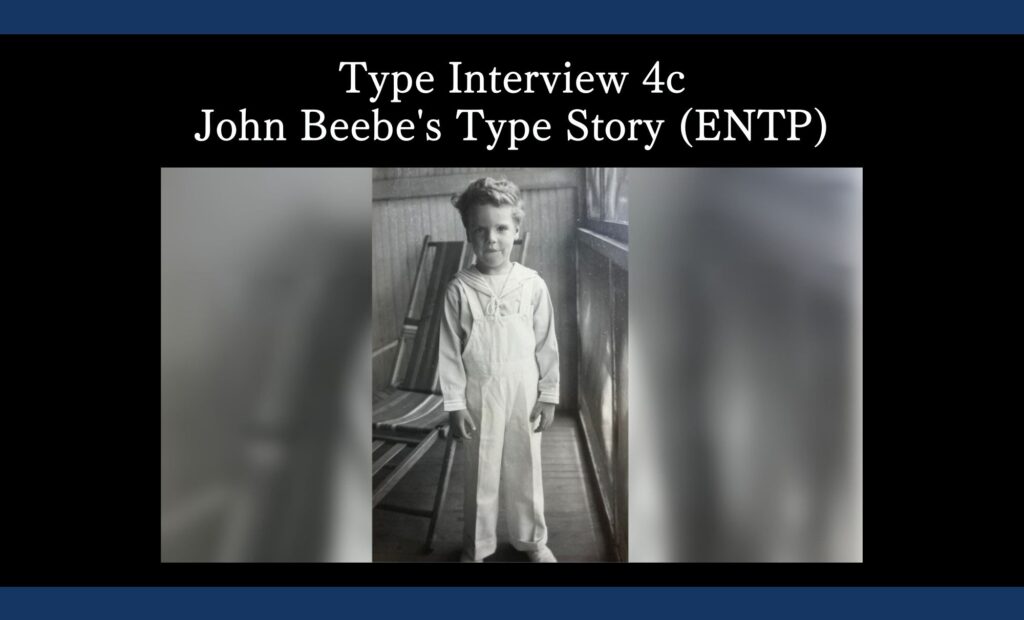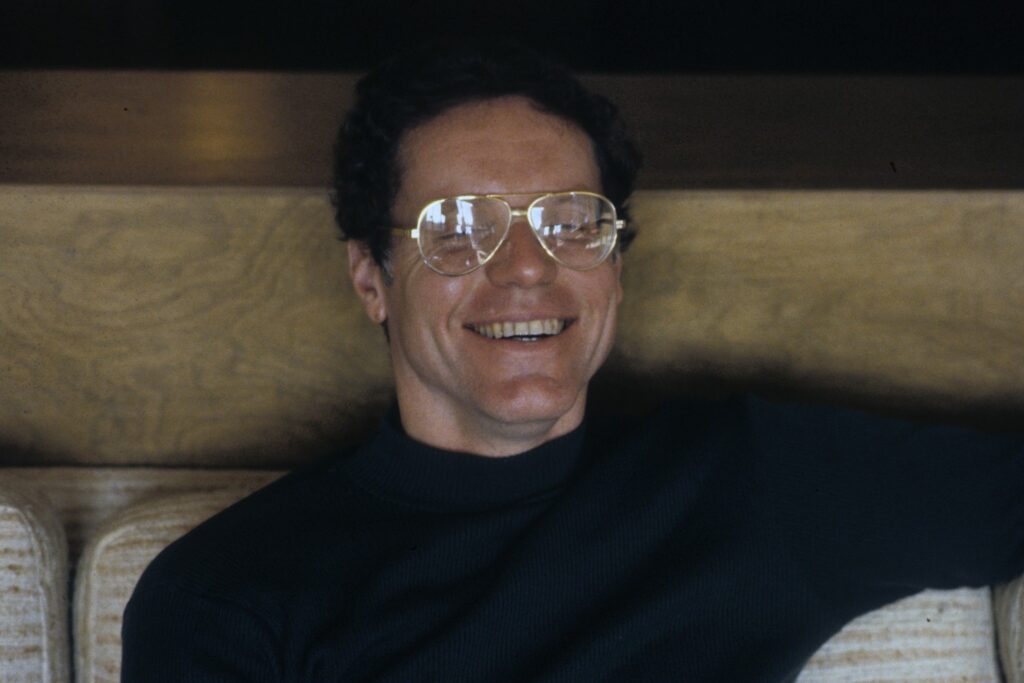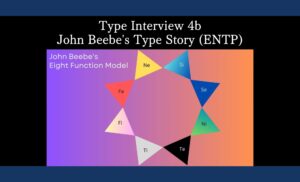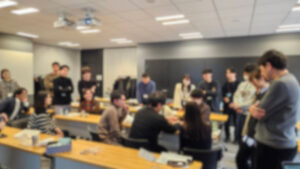
はるみ:
誰があなたにタイプを教えたのですか?それはどこで、いつのことですか?
ジョン:
まず、これは偶然の一致とも言える話です。
私は幼い頃、中国で両親と一緒に暮らしていました。
父(ESTJ)は軍の駐在武官補として派遣されていました。
しかし、母(INFJ)が父と離婚することを決め、1948年11月に私を連れてアメリカに戻りました。
私は当時9歳でした。
私たちはプリンストン(ニュージャージー州)に落ち着きました。
すると、まるで偶然のように、母がEducational Testing Service(ETS)で仕事を見つけたのです。
このETSは後にMBTIを出版することになる機関ですが、母が働いていた当時はまだMBTIを出版していませんでした。
では、誰が私にタイプを教えたのか? ある意味では、私の両親そのものが「タイプの悲劇」でした。
内向的直観(Ni)の母は、外向的感情(Fe)を補助機能として持っていました。
一方、外向的思考(Te)の父は、補助機能として内向的感覚(Si)を持っていました。二人はまさに「最悪のタイプ」だったのです。
例えば、父が母に「歯磨き粉のキャップをちゃんと閉めるように」と頼んで、少しでもルールを作ろうとすると、母は「そんなに細かいこと気にしないでよ」と言っていました。
だから、私は「タイプ戦争」が繰り広げられている家庭で育ったのです。
私は直感型だったこともあり、母の側についていました。
私は1966年の秋に、初めてタイプに関する講義を受けました。それはユング派の分析家であるメル・ケトナーが行ったものでした。
また、ユングが内向的直観型(Ni)の患者について話している映像も見ました。若き精神科医だった私は、「これは精神病理を全く異なる視点から見る方法だ」と感じました。
スタンフォード大学で精神科研修医をしていたとき、ある研究者がMBTIを使った研究を行っていて、私たち全員がMBTIを受けることになりました。
私はこうして1968年に初めてMBTIを受験しました。
当時、MBTIは一般的に広まっていたわけではなく、研究目的以外ではほとんど使われていませんでした。
私はサンフランシスコのC.G. ユング研究所で、3人のユング派の分析家に師事しました。
最初の分析家はジョン・ペリーでした。
彼が私に教えてくれたのは、ユングはおそらく内向的直観型(Ni)だったということです。
彼はこう言いました。「世間一般の見方とは違うかもしれないが…」
私は、ジョン・ペリー自身は内向的思考型(Ti)だったのではないかと思います。
2人目の分析家であるエリザベス・オスターマンは、私が内向的感覚(Si)、つまりアニマを見つける手助けをしてくれました。
それは驚くべき体験でした。
私はそのことについても執筆しています。
ジョンの著書:
「Energies and Patterns in Psychological Type」より抜粋
ーーー
『私は、自分の心理療法の実践を通じて患者たちが話してくれることすべてに強い興奮を覚え、息を詰めるようにして熱心に聞き入っていました。
そのあまり、適切に呼吸することすら忘れてしまっていました。
当然のことながら、家に帰ると片頭痛に悩まされました。
私は二酸化炭素をため込んでしまっていたのです。
そこで、患者の話を聞く際には、自分の呼吸にも注意を向けると心に決めました。
すると、それによって自分の身体への意識が開かれる空間が生まれ、セラピーを実践する中で身体感覚を意識できるようになりました。
さらに、私は気づいたのです。
自分の身体に注意を払うと、夢解釈では明らかにできない、患者の内面の手がかりが隠されていることを。
もし自分の胃や胸が緊張していると感じたら、それは患者が「張り詰めた感情」を抱えていることを示しているサインでした。
私はこうした身体感覚に意識を向け、それを最終的に患者と共有すると、自分が内面的に同一化していた感情が明らかになり、治療が前進するようになったのです。』
ーーー
私の3人目の分析家であるジョセフ・ヘンダーソンは、心理機能のタイプ論について美しく書き表し、非常に繊細にタイプ理論を活用していました。
彼は素晴らしい内向的直観(Ni)を持っていましたが、内向的感覚(Si)の価値も理解していたのです。
彼は私が自分の内向的感覚を信頼できるようにする大きな助けとなってくれました。
そして、それは長期的なプロジェクトにも役立ちました。
心理療法家としてのそのプロジェクトとは、「感情(Feeling)」の理解を深めることでした。
偏頭痛などの体の症状は、他の人が私に対して抱いている感情の影響を感じ取る手がかりであると気づくようになりました。たとえ相手がその感情を直接言葉にしなくても、私は無意識のうちにそれを受け取っていたのです。
また、私の外向的な感情(Fe)の働きに対する他人の無言の反応を敏感に感じ取ることで、内向的な感情(Fi)の特性を理解し始めることができました。
外向的な感情(Fe)は表に出やすく、すぐに共有されるのに対し、内向的な感情(Fi)は内に秘められ、簡単には表に出ないことが多いものです。
その違いを実感することで、私は感情の内向的な側面についてより深く理解できるようになりました。
ユング研究所でのもう一人の重要な教師はウェイン・デトロフでした。
彼は、イザベル・ブリッグス・マイヤーズの考えに賛同しており、優勢機能が外向であれば補助機能は内向になり、その逆も成り立つと考えていました。当時、この考えを受け入れていたユング派の分析家は多くありませんでした。
また、タイプに関する非常に重要な教師としてジョー・ウィールライトがいました。彼はアメリカで心理機能のタイプ論について語った数少ないユング派の分析家の一人でした。
後になって、私はユング派の仲間たちとタッチフットボールをしている夢を見ました。その頃、私はトレーニングの終盤に差し掛かっていました。
夢の中では、それは鬼ごっことタッチフットボールが組み合わさったようなゲームでした。そしてある時、ウィールライトが私にタッチして「お前の番だ(You're it.)」と言ったのです。
私が彼に「あなたが出てくる夢を見た」と話すと、彼はこう言いました。
「ああ、それが何を意味するか分かるよ。
それは、君が『ミスター・サイコロジカル・タイプ』になるってことだ。」
ウェイン・デトロフとは異なり、ジョー・ウィールライトは、補助機能が優勢機能とは反対の態度をとるという考えに同意しませんでした。
そのことで私たちは議論を重ねました。
ジョーと彼の妻ジェーンが一方の立場で、私がもう一方の立場でした。
もう一人の重要な教師は、マリー=ルイーズ・フォン・フランツでした。
彼女の著作『Lectures of Jung’s Typology(ユングのタイプ論講義)』における劣勢機能に関する論考が、私に大きな影響を与えました。
彼女は単一のタイプポジション(例えば優勢機能)について、8つの心理機能の可能性を検討する手法を用いていました。
私はこれに触発され、タイプダイアグラムのすべてのポジション(優勢、補助、第三、劣勢)について同様の分析を行いたいと考えるようになりました。
そして、この探求を進めるうちに、4つのポジション(優勢、補助、第三、劣勢)がそれぞれアーキタイプ的な性質を持っているのか、また、それらに「影(シャドウ)」があるのかどうかを、自分自身で深く調査しようという意欲が湧いてきたのです。
私はジェームズ・ヒルマンの講義を何度も聴き、彼と出会い、親しくなりました。彼の内向的思考(Ti)が大好きでした。
彼の講義を聴くことは、まるで偉大なジャズ奏者の演奏を聴くような体験でした。ひとつの興味深いアイデアが生まれると、それが次々と繋がっていくのです。
そして、最初にできたユング派の分析家の友人、トム・カーシュのことを忘れるところでした。彼は「君は直観型だ」と私に教えてくれました。
彼は、私を最初のユング派分析家であるジョン・ペリーに紹介してくれました。
ペリーは、夢を扱う優れた能力を持っており、彼の指導のもと、私は自分の外向的直観(Ne)を、より正確なイメージを通じて地に足のついたものにする方法を学ぶことができました。
私はこれまで、自分が飛び込んでいく状況がどんな意味を持つのかを完全には理解しないまま進んでしまうことがよくありました。
しかし、夢を通じて、それらの状況を象徴する正確なイメージを受け取ることで、私は自分の直観をより確信を持って活かせるようになったのです。
の少し後に、メアリー・マコーリー(INFP)と出会いました。彼女は私の講義を聞き、その後、キャシー・マイヤーズ(INFP)とも知り合いました。
彼女たちはイザベル・ブリッグス・マイヤーズと親しくしていた人物であり、私がやっていることは単にユングの理論を発展させるだけでなく、マイヤーズの仕事にも貢献し、拡張するものだと教えてくれました。
この言葉によって、ユングのタイプ論とマイヤーズのMBTIの伝統は、別々の学問領域として分断される必要はないという、私の外向的直観(Ne)のひらめきに自信を持つことができました。
また、私はこれまでに多くの人々からタイプについて学んできました。
私の講義を受講した人々や、今回のように私にインタビューしてくれた人々からも、たくさんの気づきを得ています。
そして最後に、私のパートナーであるアダムもまた、私にとって重要な学びの存在です。
彼は内向的感覚(Si)タイプであり、最初から私の理論を気に入り、その正しさを裏付け、明確に説明できる能力を持っていました。
だからこそ、私は本当に多くの人々から学んできたのです。
2000年代初頭、私はある夢を見ました。
夢の中で、私はユングと話をしていました。彼はまるで130歳くらいになっているようでした。
そして彼は私にこう言ったのです。
「君がタイプ論に対して行ってきたことを、本当に気に入っているよ。」
私はそれを聞いて、これ以上ない最高の承認をもらったと思いました!
私は、ユングが私たちに残してくれたものを受け継ぎ、タイプが「自己(Self)」をどのように構成するのかを探求してきました。
「自己(Self)」は自我(Ego)とは異なるものです。
そう考えると、私は本当に幸運な人間だと思います。

私が子どもの頃、バスに乗っているときにあるゲームをしていました。
誰かがバスに乗ってくると、その人を見て、「この人を以前どこで見たことがある?」と自分に問いかけるのです。
じっくりとその人の顔を見ていると、過去に出会った誰かとそっくりな人物を思い出すことができました。
ただの見た目の類似ではなく、その人の態度や心理的な立ち位置までも含めて、そっくりな人物を思い出していたのです。
今振り返ると、私は当時からすでに「タイプ論的な思考」をしていたのだと思います。
私は記憶の中から「プロトタイプ(原型)」を探し出していたのです。
おそらく、これは私にとっての劣勢機能「内向的感覚(Si)」のゲームだったのでしょう。
それは単に「外見の類似性」だけではありませんでした。
その人の態度や心理的なスタンスまでを捉え、それと一致する人物を記憶の中から引き出していたのです。
取材・文 権藤晴美
※インタビューオリジナル全文※

Harumi: Who taught you type and where and when?
John: Well, first, a synchronicity. As a young boy, I had been living in China with my parents. My father (ESTJ) was posted there as an assistant military attache. Then my mother (INFJ) decided to divorce my father. She came back to America with me in November 1948.
I was nine years old. We found our way to Princeton, New Jersey, where, seemingly by chance, she got a job at Educational Testing Service, the very place that later published the MBTI, although they weren't publishing it during her time working there.
So who taught me type? Well, part of it was that my parents were a type tragedy.
My introverted intuitive mother had extraverted feeling on the side. My extraverted thinking father had auxiliary introverted sensation. Together, they were a type disaster.
Whenever my father would try to get her to put the cap back on the toothpaste tube and create some order in the bathroom, she would say, “don't be so damn technical.”
So, I grew up in a home where there was a type war going on. I was on my mother's side, because I was also intuitive.
I went to my first type lecture in the fall in 1966. It was given by Mel Kettner, a Jungian analyst.
Also, I saw Jung on film talking about an introverted intuitive patient. As a young psychiatrist, I said, this is a wholly different way of looking at psychopathology.
When I was a psychiatric resident at Stanford, someone was doing a research study, and they used the MBTI and gave it to all of us. So I first took the MBTI in 1968. Nobody was doing MBTI in 1968 in a general way, except in research.
I had three Jungian analysts at the C. G. Jung Institute of San Francisco. The first was John Perry.
He was the one that taught me that Jung was probably introverted intuitive. He said, “It's not the way most people see it.” I think John Perry was an introverted thinking type.
My second analyst, Elizabeth Osterman, helped me find my introverted sensation, anima.
That was incredible. I've written about that.
Excerpt from John's book, Energies and Patterns in Psychological Type:
"I was very excited to hear everything they (patients in my developing psychotherapy practice) were telling me, so much so that I was listening with bated breath, neglecting even to breathe properly. No wonder I came home to migraine headaches: I was retaining carbon dioxide. I made up my mind that I would to attend to my breathing while listening to patients. This opened a series of spaces that allowed me to be aware of my body as I practiced therapy. I then noticed that in my body, as I attended to it, were clues to what was going on in my patient beyond anything dream interpretation could have revealed. If my stomach or chest felt tense, that was a signal that my patient was feeling 'uptight,' I found if I attended to these sensations, and eventually took up with the patient the feelings I was introjectively identifying, relevant material would emerge which would move the therapy forward."
My third analyst, Joseph Henderson, wrote beautifully about psychological types and used the type theory very sensitively.
He had wonderful introverted intuition, but he saw the value of introverted sensation.
He (Joseph Henderson) helped me tremendously to trust my introverted sensation. And that also helped me with a longer term project, which as a psychotherapist was to deepen my understanding of feeling.
I could start to see my own body symptoms, such as migraine headaches, as my way of sensing the impact of feelings other people were harboring about me, even they were not talking directly about them to me.
Picking up other people’s unspoken reactions to my efforts at extraverted feeling enabled me to start to understand the introverted dimension of feeling, which often is withheld, unlike the extraverted side of feeling that is so readily shared.
Another important teacher at the Jung Institute was Wayne Detloff. He agreed with Isabel Briggs Myers that if the dominant function is extraverted, the auxiliary will be introverted and vice versa. That was not something that most Jungian analysts believed at that time.
A very important teacher about type was Jo Wheelwright. He was one of the few Jungian analysts in America who spoke about psychological type.
I later had a dream in which I was playing touch football with various Jungians. This was when I was in my late stages of training, and in the dream, it was a combination of tag and touch football. At a certain point, he tagged me and said, “You're it.”
When I told him I had had that dream about him, he said, “Oh, I know what that means. It means you're going to be Mr. Psychological Type.”
Unlike Wayne Detloff, Jo Wheelwright didn’t agree that the auxiliary function takes the opposite attitude from the dominant. We fought about that, Jo and his wife, Jane, on one side and me on the other.
Another important teacher was Marie-Louise von Franz, through her published piece on the inferior function in Lectures of Jung’s Typology.
Her use of an eight function survey of the different possibilities for a single type position opened the door to my wanting to do that for every position on someone’s type diagram (superior, auxiliary, tertiary, and inferior). And that moved me to investigate for myself whether the four positions themselves had archetypal qualities and whether they had shadows.
I heard James Hillman lecture many times and met him and became friendly with him. I loved his introverted thinking. Hearing him lecture was like listening to a great jazz instrumentalist play: one interesting idea after another.
And I’m nearly forgetting my first Jungian analyst friend, Tom Kirsch, who told me I was an intuitive type.
He referred me to my first Jungian analyst, John Perry whose ability to work with dreams opened me up to hearing their way of grounding my extraverted intuition with accurate images of the situations I kept nosing my way into without fully understanding what they portended.
A little later, I met Mary McCaulley (INFP), who heard me lecture, and then Kathy Myers (INFP), both of whom had been close to Isabel Briggs Myers and let me know that what I was doing was adding and extending to her work and not just to Jung’s. That gave me confidence in my extraverted intuitive hunch that the two type traditions (Jung’s and Myers’s) need not remain entirely separate tracks for learning type.
I’ve also learned about types from so many of the people who have attended my lectures or interviewed me as you are doing.
Finally, my partner, Adam, an introverted sensation type, loved my theory from the very beginning and is able to verify it and explain it very clearly.
So, I’ve learned from a lot of people.
Sometime in the early 2000s, I had a dream. In the dream, I am talking to Jung and he was something like 130 years old. And he tells me, “I really like what you've done with the types.”
I thought that was the best validation I would ever get!
I've tried to take what Jung gave us and see how the types organize the self, which is not the same as the ego.
So I consider myself an immensely lucky person.

When I was young, I would play a game when I was on the bus. When somebody got on the bus, I would look at the person, and I would say to myself, "where have I seen this person before?"
I would look at their face and gradually I'd remember one person that I had met before that was actually like them in every way. So I think I was actually thinking typologically even then.
I was finding in my memory, the prototype, I guess it would be a kind of introverted sensation, inferior function game. The configuration wasn't just physical, it was their attitude, their psychological stance that I was picking up.
Interviewed and written by Harumi Gondo



“Type Interview 4c / Type Story : ジョン・ビービー( ENTP )” に対して2件のコメントがあります。